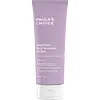First Aid Beauty KP Bump Eraser Body Scrub With 10% AHA Versus Paula's Choice Weightless Body Treatment 2% BHA
What's inside
What's inside
 Key Ingredients
Key Ingredients

 Benefits
Benefits

 Concerns
Concerns

 Ingredients Side-by-side
Ingredients Side-by-side

Pumice
AbrasiveWater
Skin ConditioningGlycolic Acid
BufferingSodium Cocoyl Isethionate
CleansingLactic Acid
BufferingDimethicone
EmollientStearic Acid
CleansingCetearyl Alcohol
EmollientSodium Hydroxide
BufferingPalmitic Acid
EmollientGlycerin
HumectantC12-15 Alkyl Benzoate
AntimicrobialSorbitol
HumectantColloidal Oatmeal
AbsorbentTocopherol
AntioxidantChrysanthemum Parthenium Extract
Skin ConditioningCamellia Sinensis Leaf Extract
AntimicrobialGlycyrrhiza Glabra Root Extract
BleachingSalix Nigra Bark Extract
Skin ProtectingBisabolol
MaskingHydrogenated Coconut Acid
EmollientXanthan Gum
EmulsifyingSteareth-20
CleansingSteareth-21
CleansingMyristic Acid
CleansingSodium Isethionate
CleansingPhenoxyethanol
PreservativePotassium Sorbate
PreservativeSodium Benzoate
MaskingLeuconostoc/Radish Root Ferment Filtrate
AntimicrobialEDTA
Pumice, Water, Glycolic Acid, Sodium Cocoyl Isethionate, Lactic Acid, Dimethicone, Stearic Acid, Cetearyl Alcohol, Sodium Hydroxide, Palmitic Acid, Glycerin, C12-15 Alkyl Benzoate, Sorbitol, Colloidal Oatmeal, Tocopherol, Chrysanthemum Parthenium Extract, Camellia Sinensis Leaf Extract, Glycyrrhiza Glabra Root Extract, Salix Nigra Bark Extract, Bisabolol, Hydrogenated Coconut Acid, Xanthan Gum, Steareth-20, Steareth-21, Myristic Acid, Sodium Isethionate, Phenoxyethanol, Potassium Sorbate, Sodium Benzoate, Leuconostoc/Radish Root Ferment Filtrate, EDTA
Water
Skin ConditioningButylene Glycol
HumectantCetyl Alcohol
EmollientPPG-14 Butyl Ether
Skin ConditioningSalicylic Acid
MaskingDimethicone
EmollientTocopheryl Acetate
AntioxidantChamomilla Recutita Flower Extract
MaskingEpilobium Angustifolium Extract
Skin ConditioningCamellia Oleifera Leaf Extract
AstringentVanilla Planifolia Fruit Extract
Skin ConditioningBisabolol
MaskingAllantoin
Skin ConditioningCyclopentasiloxane
EmollientCyclohexasiloxane
EmollientDimethiconol
EmollientPEG-40 Stearate
EmulsifyingSorbitan Stearate
EmulsifyingPvm/Ma Decadiene Crosspolymer
Polyacrylamide
C13-14 Isoparaffin
EmollientLaureth-7
EmulsifyingDisodium EDTA
Sodium Hydroxide
BufferingHexylene Glycol
EmulsifyingCaprylyl Glycol
EmollientCaprylic/Capric Triglyceride
MaskingEthylhexylglycerin
Skin ConditioningPhenoxyethanol
PreservativeWater, Butylene Glycol, Cetyl Alcohol, PPG-14 Butyl Ether, Salicylic Acid, Dimethicone, Tocopheryl Acetate, Chamomilla Recutita Flower Extract, Epilobium Angustifolium Extract, Camellia Oleifera Leaf Extract, Vanilla Planifolia Fruit Extract, Bisabolol, Allantoin, Cyclopentasiloxane, Cyclohexasiloxane, Dimethiconol, PEG-40 Stearate, Sorbitan Stearate, Pvm/Ma Decadiene Crosspolymer, Polyacrylamide, C13-14 Isoparaffin, Laureth-7, Disodium EDTA, Sodium Hydroxide, Hexylene Glycol, Caprylyl Glycol, Caprylic/Capric Triglyceride, Ethylhexylglycerin, Phenoxyethanol
 Reviews
Reviews

Ingredients Explained
These ingredients are found in both products.
Ingredients higher up in an ingredient list are typically present in a larger amount.
Bisabolol is famous for its skin soothing properties. It does this by blocking inflammatory signals, helping to reduce your body's reaction to irritation.
This ingredient also interferes with the process of hyperpigmentation. This can help with reducing dark spots and uneven tone.
Bisabolol is an antioxidant. Antioxidants help fight free-radicals. Free-radicals are molecules that may damage your skin cells. By fighting these free-radicals, Bisabolol may slow down signs of aging.
Studies have shown Bisabolol to have antimicrobial properties and may be a fungicide. These properties help preserve a product's shelf life.
All these properties makes bisabolol a great skin barrier helper ingredient.
Bisabolol also helps the absorption of other ingredients.
Note: Synthetic Bisabolol has been shown to be less effective.
Learn more about BisabololDimethicone is a type of synthetic silicone created from natural materials such as quartz.
What it does:
Dimethicone comes in different viscosities:
Depending on the viscosity, dimethicone has different properties.
Ingredients lists don't always show which type is used, so we recommend reaching out to the brand if you have questions about the viscosity.
This ingredient is unlikely to cause irritation because it does not get absorbed into skin. However, people with silicone allergies should be careful about using this ingredient.
Note: Dimethicone may contribute to pilling. This is because it is not oil or water soluble, so pilling may occur when layered with products. When mixed with heavy oils in a formula, the outcome is also quite greasy.
Learn more about DimethiconePhenoxyethanol is a preservative that has germicide, antimicrobial, and aromatic properties. Studies show that phenoxyethanol can prevent microbial growth. By itself, it has a scent that is similar to that of a rose.
It's often used in formulations along with Caprylyl Glycol to preserve the shelf life of products.
Sodium Hydroxide is also known as lye or caustic soda. It is used to adjust the pH of products; many ingredients require a specific pH to be effective.
In small amounts, sodium hydroxide is considered safe to use. However, large amounts may cause chemical burns due to its high alkaline.
Your skin has a natural pH and acid mantle. This acid mantle helps prevent harmful bacteria from breaking through. The acid mantle also helps keep your skin hydrated.
"Alkaline" refers to a high pH level. A low pH level would be considered acidic.
Learn more about Sodium HydroxideWater. It's the most common cosmetic ingredient of all. You'll usually see it at the top of ingredient lists, meaning that it makes up the largest part of the product.
So why is it so popular? Water most often acts as a solvent - this means that it helps dissolve other ingredients into the formulation.
You'll also recognize water as that liquid we all need to stay alive. If you see this, drink a glass of water. Stay hydrated!
Learn more about Water